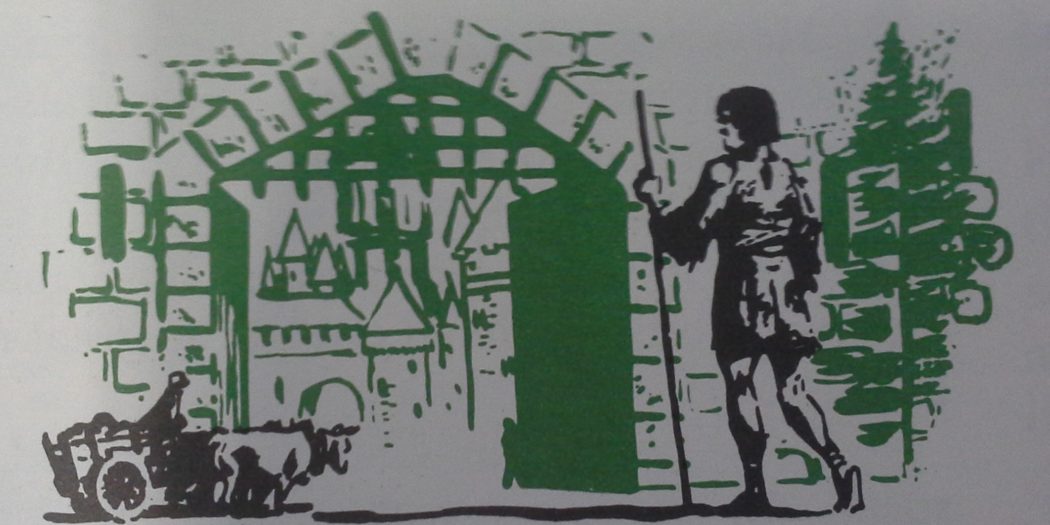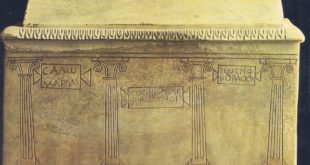Pierre watched the merchant caravan clatter down the narrow dirt road that led through the manor. Pack mules threaded their way to avoid the deep puddles, while the horses strained as they pulled the creaking two wheeled carts. Pierre envied the merchants as well as the sturdy bowmen who guarded the caravan. During his seventeen years Pierre had never been more than a few miles from the manor where he had been born a serf. He was not free to move around as were these merchants who were city folk. Was it true, as Pierre had heard, that a serf who escaped to a town or city and lived there for a year and a day was forever free? He wondered.

As towns began to dot western Europe, trade quickened and ways of living changed.
The merchant caravan disappeared around the bend in the road. Should Pierre follow it? To stay on the manor meant a serf’s life — a life of back-breaking toil. That night after dark, his mind made up, Pierre slipped unseen across the fields and onto a narrow path that led over the surrounding hills. For two nights he walked as rapidly as he could, sleeping fitfully in deep thickets during the daylight hours. Soon after sunrise on the second morning the forest trail led to a wider road, an hour’s journey out of the city of Lacourt. Pierre helped to free an oxcart bogged down in the mire of the roadside ditch and then trudged toward Lacourt in the company of the grateful driver.
The young serf’s eyes grew wide with wonder at the unfamiliar sights as he approached the outskirts of the city. Completely encircling it was a wall of stone four times the height of a man. At one point the wall was pierced by a gateway, its great oaken doors swung back. Through the opening Pierre could see rows of steep roofed houses. High above them all rose the cathedral, its towers alight in the rays of the early morning sun. Over the gateway hung the huge portcullis, a heavy door or iron grating, which could be lowered quickly in the face of an enemy attack. Pierre now realized how the city could be defended. He began to understand the common saying, “City air is free air.” People were free in cities because they could defend their freedom. Could Pierre live out his year and a day at Lacourt? To do so he must learn the ways of the city.

This story of the imaginary serf Pierre calls attention to a different sort of medieval life. During the later Middle Ages (1000-1500), however, as conditions grew more settled in western Europe, important developments took place. None was more significant than the revival of town life. Towns and cities offered an inviting opportunity to escape from the dull drudgery of existence on a manor. Town life changed people’s ways of living and thinking to the newer ways, more like our own, that we call “modern.” To understand these changes, you will want to find
the answers to the following questions:
1. How did townspeople live and work during the later Middle Ages?
2. How did the Crusades change people’s customs and ways of thinking?
3. What progress was made in architecture and leaming in the later Middle Ages?
4. What changes were brought about by the Renaissance?
1. How Did Townspeople live and work during the Later Middle Ages?
Town life did not die out completely during the early Middle Ages. Although the great majority of people lived on manors during the early Middle Ages, town life had not entirely disappeared. There were communities which had been founded in the days of the Romans or even earlier. For example, there are more than 100 towns in France today that date back to Roman times. As conditions became more settled in western Europe, the number of towns and cities increased and those already in existence became larger.
The growth of trade favoured the growth of towns. Towns and cities did not spring up overnight or for any one reason. High on the list of causes of the growth of towns, however, was the revival of trade.
Teutonic invasions, Moslem conquests and Viking raids, struck deadly blows at the free flow of trade which had existed throughout the Roman Empire. Not only was western Europe cut-off from trade with the outside world by these events, but there was little encouragement to commerce at home. Farmers and craftsmen had few surplus products to sell. Poor roads, heavy local tolls (taxes), roving bands of robbers and the fact that the manors were largely self-supporting discouraged all but a small number of venturesome merchants. No system of money was in wide use and coins had no fixed values. More goods were exchanged by barter than by purchase and sale.
As the feudal system became well established in western Europe, however, some degree of order was restored. The demand for goods increased and trade began to revive. Towns appeared where the main land routes crossed and where rivers or the sea enabled people to use the water as a roadway of commerce. Moreover, certain Italian cities, notably Venice, reopened trade with Constantinople and the East.
The desire for security encouraged the growth of towns. In an age of warfare and disorder, protection was important. People therefore flocked to places where geographic conditions or the presence of a castle or a powerful churchman offered safety.
Paris, for example, was first built on an island in the Seine River. London, on the banks of the Thames River, had the protection of marshy ground as well as of the river. Where small castles were built, small settlements tended to grow into larger communities. The people in the castle wanted the goods and services which merchants and craftsmen could provide, while in times of danger the lord’s castle could provide protection for the townspeople. Communities also grew up outside the walls of monasteries. High ranking churchmen often used their power to enforce peace in a neighborhood. Merchants and craftsmen therefore moved into cathedral towns or cities where bishops enforced the law and kept the walls in repair to ward off attack. Such places became busy centres of trade and industry. In time the open squares in front of the cathedrals became bustling market places.
Towns grew where natural resources were developed. The location of natural resources was another reason for the growth of towns. Many a town or city on the shores of the North Sea, for example, owed its existence to a plentiful supply of herring in the nearby waters. Sheep raised in what is now Belgium grew an especially fine wool, some Belgian towns became centres for the weaving of woolen cloth. Where there were lead or iron mines, towns appeared. Metalworkers settled near the mines so as to obtain the raw materials more cheaply and traders came to buy the goods the metalworkers produced.
Work opportunities were greater in the towns. As towns grew in size, the variety of occupations carried on by their inhabitants increased. To the trading centres, the woolen centres and the fishing centres came weavers, shoemakers, bakers, butchers, carpenters, tailors and other craftsmen. The more people there were in a town, the greater was the need for a variety of goods and services. In a town, in short, a man had a better chance to make something of himself.
Towns were crowded and unsanitary. What were towns and cities like about the year 1850? For one thing, they were small by present day standards. Rarely did medieval towns contain more than 5000 inhabitants and there were no cities any where near the size of modern London or Paris.
Towns and cities in the Middle Ages had their high stone walls and turrets, their busy market places; and great churches or cathedrals with spires reaching toward the sky, but not all was beauty and romance. Dwellings had to be within the protection of the walls, towns were badly overcrowded. Houses were often four or five stories high, with the upper stories jutting forward beyond the lowest story, so that people upstairs could almost shake hands across the street. The narrow, winding streets were sometimes paved with rough cobble stones, but more often were unpaved. There was no plumbing as we know it. Garbage and rubbish were dumped by householders into the middle of the street. Passers-by had to pick their way around mud puddles or circle the fowls and pigs that roamed the streets eating the refuse. A heavy rain was required to wash the streets reasonably clean. If you could visit a medieval town, you would probably hold your nose.
To the dangers of disease brought about by improper disposal of waste materials must be added others resulting from lack of a pure water supply. People had to draw their water from shallow wells dug in the public square or at street intersections. Drainage from the streets of course seeped into the wells. Even if a pure stream or brook flowed into the town, it was soon unfit for drinking. So townspeople drank chiefly ale or wine.
Medieval towns had other dangers. In addition to overcrowding and lack of sanitation there was the ever present peril of fire. City dwellers generally used fireplaces to heat their houses, though portable charcoal burning stoves were occasionally employed. Many fires broke out and frequently entire towns were destroyed. Thatched roofs added to the fire menace and the projecting upper stories made it easier for flames to leap across the street to destroy the houses opposite. Once a fire broke out it was difficult to keep it from spreading, especially since fire-fighting was usually limited to carrying buckets of water from a brook, a river, or a nearby well. When slate roofs replaced thatch and walls of stone replaced walls of wood, fires spread less rapidly. Nevertheless many a medieval town was swept by disastrous fires on more than one occasion.

Darkness brought additional hazards to the city dweller. Streets were lighted poorly if at all. The only police protection was furnished by a few elderly watchmen who were no match for the robbers and other tough characters who lurked in dark doorways and alleys. Few peaceable folk ventured forth after dusk except on urgent business.
Yet it should be pointed out that while the conditions described above were widespread, some cities made distinct progress in matters of public health and safety.
Merchants organized guilds. As city life revived, the merchants of a particular town usually banded together in an organization called a merchant guild. Membership in the merchant guild, or hanse as the organization was called in northern Europe, provided many advantages. Greater protection was afforded merchants transporting goods overland or by sea. Laws gave guild members the sole right to sell certain kinds of goods in their own town or city. Guild members aided one another in many ways. If a guildsman died, the guild, if necessary, cared for his widow and children.
The merchant guilds also developed a system of commercial law. Naturally the laws and customs of the manor would not be suited to the needs of commerce. Slowly merchants learned the best and surest ways to make their contracts and other business arrangements. In this manner, laws concerning trade and commerce gradually became established. Such laws were an important part of the foundation on which modern business has been built.
Craft guilds also were organized. As towns and cities increased in number and population and as the demand for finished products grew, skilled craftsmen of various kinds became more numerous These workers formed their own guilds so that they might have advantages sim ilar to those of the merchant guilds. In time, especially after 1300, the craft guilds became more influential than the merchant guilds.

Look in your telephone directory for such names as Draper, Fletcher, Fuller, Taylor, Potter, Miller, Smith, Tanner, Wright and Mason. You may find a considerable number, for they are the names of craft guilds of the Middle Ages. A draper, for instance, made and sold cloth. A fletcher made bows and arrows — a high-priced specialty much in demand. Fullers were people who cleaned and pre-shrank cloth. Tailors, of course, made clothing. A townsman went to a potter for dishes, bowls and vases. Millers ground grain in their mills. Smiths, such as the blacksmith, coppersmith, silver smith, goldsmith and tinsmith, made articles of iron, copper, silver, gold, or tin and mended them as well. Tanners made leather from hides. The wrights, too, were craftsmen. There was the millwright, for instance, who built mills for the miller, the wheelwright and the shipwright. There was also the mason, who built stone walls and chimneys. To help people who could not read, the craftsmen hung out signs picturing their craft. A cobbler might have a huge boot in front of his shop — as some still do; a spur maker, a large pair of gilded spurs. The barber, who also did a little crude surgery, used a red cloth (which represented a bloody bandage) wrapped spirally around a white pole. Present-day barber poles have developed out of this practice.
Craft guilds had three grades of workers. Becoming a skilled craftsman took time. (1) A boy or young man who wanted to learn a trade in the Middle Ages was apprenticed to a master for a term of years. The apprentice lived in the master’s house, receiving food and clothing as well as lodging from the master. At first he ran errands and swept the shop and at night helped to hang the heavy shutters that protected the windows. The apprentice was expected not only to make himself useful in small ways around the shop, but also to learn his master’s trade. Sometimes the apprentice was paid a small wage.
(2) After a certain number of years, depending upon the nature of the trade, the apprentice became a journeyman. This meant that he could now “hire out” to some master and work for wages. By so doing, the wide-awake journeyman learned still more of the secrets, or mysteries, of the trade.
(3) In time it was possible for an ambitious and capable journeyman to become a master himself. Two steps were necessary to make this advance. First, the journeyman had to get together enough money to open a shop of his own. This might be done through careful saving, but not infrequently a journeyman increased his wealth by marrying one of the master’s daughters. Second, he had to create a masterpiece of his own to prove his expertness at his craft. If the masters of his craft in his city approved this masterpiece, the former journeyman could then open his own shop, have his own apprentices and hire journeymen to help him. Such a man was then a master in his guild and was looked up to as a worthy, responsible citizen. Even though he had attained this high position, the master usually was on friendly terms with his helpers and worked side by side with them in his shop.
Members of craft guilds had privileges and responsibilities. Craft guilds provided many benefits for their members. Guilds protected honest workmen by fining those who produced inferior goods. Unless the craft guilds gave their permission, people from another town or city were not permitted to sell their goods in the city. The craft guilds, as did the merchant guilds, provided a fine funeral for a member who had died and a pension for his widow “so long as she behaves herself and so long as she does not marry again.” A member of a guild who could not finish his work on time, because of illness or a heavy rush of orders, could count on fellow guildsmen to help him out.

Guild members were subject to many regulations. Most of these were established by the guilds themselves. Masters were forbidden to abuse their apprentices and journeyman. Craft guilds fined masters who compelled their men to work on Sundays, holidays, or at night. The guilds also determined what prices to charge and any guild member who tried to raise prices unfairly soon found himself in trouble. There were town and city regulations, too. Some of these barred young persons, then as now, from premises where liquor was sold. There were also sanitary regulations which barbers had to follow.
Guilds played an important part in city life. Guilds contributed to the construction of cathedrals, other churches and of town halls. Magnificent guildhalls ranked among the most imposing buildings in many cities and served as centres for community events. On holidays all guild members paraded with the banners of their guilds. Guilds gave plays, supported hospitals and contributed generously to charities. Guildsmen often served as city or town officials. In fact, in some cities only guild members could take part in the local government.

Guilds, then, contributed much to the progress of medieval towns. But, it must be added, the guild system had its draw backs. Under strict guild rules, there was little chance for the individual craftsman to develop better methods of production or to increase his output of goods. Moreover, the prices set by the guilds were sometimes higher than they needed to be.
Fairs spread trade and ideas. Fairs somewhat like our own state or county fairs were popular in the Middle Ages. On the map you will find an area called Champagne in eastern France. This broad, open plain was a natural route for traders travelling overland between Italy and northern France and the Low Countries (Belgium and Holland). Fairs were established both here and in other parts of Europe where important trade routes crossed.
Fairs usually took place yearly. Outside of a large town or city, merchants from many countries would set up booths in which to exhibit their goods. You can imagine how people must have stared when they first saw silks, oriental rugs and inlaid cabinets of fine wood. If they had money, they bought. Street shows and plays entertained the crowds. There were festivals in honour of the saints and “miracle plays” which impressed on people’s minds the lessons of the Bible. Wandering jugglers and acrobats, chained bears that fought dogs and roosters specially bred for their fighting qualities were common attractions. Townsmen and freeman from the nearby manors flocked to the fair. It was exciting to see things from far away and to hear people speaking strange languages. So fairs not only made possible the exchange of goods but spread ideas and knowledge of the outside world.
Towns and cities became self-governing. As medieval towns grew and prospered, many of them obtained the right to rule themselves. Why did this happen? The answer is that shrewd townspeople bargained and bought their freedom from the noble or churchman on whose land the town stood. Once townspeople had won their freedom, they guarded it carefully, even fighting to keep it. Town self-government became widespread shortly after 1100.
Townsmen bargained for privileges. Self government grew out of the needs of two groups — lords and kings. Towns not only encouraged trade, but gave the lords of neighbouring manors a chance to increase their incomes. More than one noble started a town on the land he controlled by offering privileges to merchants and craftsmen. Some towns gained such a degree of self-government that their citizens even coined their own money, collected their own tolls or taxes on goods and traffic at the city gates and made their own laws. Such towns were, in fact, small city states, proud of their independence.
Sometimes a city’s rights were written into a contract, called a charter, which the lord signed. Not all charters provided the same privileges, nor were the new towns the only ones to possess charters which guaranteed their rights. Older towns got charters too; otherwise people might move from an older town to a new one. To keep their citizens, the old towns had to offer as attractive privileges as the new towns promised.
From time to time towns also won special rights from kings who were at war with powerful feudal lords. Kings were often willing to grant greater rights and privileges to towns in return for loans.
After all, the townsfolk had most of the ready cash. Such bargains pleased both townspeople and kings: (1) The towns folk got the liberty they wanted. (2) The kings got the cash they needed. (3) Both were glad of the chance to weaken the power of the feudal lords of the neighbouring manors.
2 How Did the Crusades Change People’s Customs and Ways of Thinking?
The Crusades helped to awaken Europe. Your father or possibly some other relative may have served in Europe, among the islands of the Pacific, or on the mainland of Asia during or after World War II. If so, he may have told you a little about these distant lands and how the people there Iive — facts he might never have learned if the war had not taken him abroad. A series of wars known as the Crusades created the same kind of opportunity for Europeans in the Middle Ages to “see the world.” The revival of trade and the growth of towns had already begun. New knowledge was seeping into western Europe from the Moslem world. These developments might have been much slower had it not been that during a period of more than 150 years thousands of Crusaders journeyed to the Near East. These Crusaders brought back to their homelands products, customs and ideas that were new to Europeans in the Middle Ages. In particular, the Crusades stimulated trade, which in turn quickened the growth of cities and towns.
The Crusades were a long series of wars against Moslems. The Crusades were military expeditions, fought chiefly by Christians against Moslems. The name Crusade comes from the Latin word crux, which means “cross.” A red cross on a white tunic was often worn by people who joined the Crusades.
There was the rapid spread of MosIem power. In the course of their conquests, the warlike Arabs and Turks overran Palestine, the area which Christians call the Holy Land because Jesus had lived and died there. Shortly before 1100 it became very difficult for Christians to journey to the holy city of Jerusalem or to visit the little village of Bethlehem, Jesus’ birthplace.
The Pope called upon Christians to conquer the Holy Land. In the autumn of 1095 Pope Urban II journeyed to Clermont in France. There he spoke to a large gathering of churchmen, powerful French lords and their soldiers. Said the Pope:
. . . I urge you men of all ranks, knights as well as foot soldiers, rich as well as poor, to exterminate this race [the Turks]. . . . I speak to those present; I proclaim it to the absent; moreover Christ commands it. And if those who set out should lose their lives, their sins shall be forgiven, This I grant to all who go. . . . Let those who have been accustomed to make private war, carry on against infidels. Let those who for a long time have been robbers now become soldiers of Christ. Let those who once fought against brothers and relatives now fight against barbarians. Let those who have worked for wages now work for an eternal reward. Let no obstacle stand in the wav of those who are going. After their affairs are settled and expense money is collected and when spring has come, let them undertake the journey under the guidance of the Lord.
This was the stirring message that launched the Crusades, the call that united the armed warriors of western Europe.
Men joined the Crusades for many reasons. Religious enthusiasm, however, was not the only reason why thousands of people set out on Crusades to the Holy Land. Many knights were moved by a spirit of adventure and a love of battle. Young knights, whose elder brothers by law would inherit their fathers’ lands, went with the hope of obtaining rich manors for themselves. Even some serfs and villeins, hoping to better their condition, managed to join the ever-growing streams of people who headed southward and eastward to drive the Turks from the Holy Land.

The first Crusades to the Holy Land failed to achieve a lasting victory. During 1096 thousands of western Europeans rushed to take part in the Crusade. Two groups consisted largely of untrained, poorly armed people who had neither sufficient food nor accurate maps. Their leaders were a penniless knight named Walter and a soul-stirring preacher called Peter the Hermit. These ill-prepared people were of course doomed from the start. Most of them died on the way or became discouraged and returned home. A far better organized force of Crusaders was more successful. In 1099 this army captured Jerusalem. The victorious Crusaders chose a French noble named Godfrey to rule the holy city. Godfrey would not allow himself to be called “king.” He said he could never wear a crown of gold where his Master had worn a crown of thorns. The so called First Crusade (1096-1099) was a great victory for the Crusaders.
The triumph of the Crusaders, however, was not lasting. A Second Crusade failed to hold back a new surge of Moslem power. When the Moslems recaptured Jerusalem in 1187, the kings of France, England and the German emperor planned the Third Crusade. They would show the Moslems what war really was; they would drive the infidels from the Holy Land! Jealousy and rivalry, however, kept these rulers from working together. The German emperor was drowned while in Asia Minor and the French king soon went home. Of the three rulers only the dashing Richard, the Lion Hearted of England remained, but he was unable to reconquer Jerusalem.
More Crusades to the Holy Land took place. In spite of setbacks, Christians continued to respond to the crusading spirit. There was, for example, the so-called Children’s Crusade. The boys and girls who took part in it never reached Jerusalem. Some got as far as Rome but the Pope sent them back home. Others were not so fortunate. They became homeless wanderers or were put aboard ship by flint-hearted traders and sold to Moslem slave buyers. Many died of disease or starvation.

Several other Crusades were launched during the 1200’s, but none achieved real success. Many Crusaders became interested in carving out little feudal states for themselves along the Mediterranean coast. Encouraged by the Venetians, one force of “Crusaders” even captured and looted the Christian city of Constantinople! Fighting with each other weakened the Christians and before 1300 they had been driven from the Holy Land. Not until late in World War I, more than 600 years later, did a Christian army re-enter jerusalem.
Not all Crusades were fought in the Holy land. The Crusades were not entirely confined to wars fought between Christians and Moslem Turks in the Near East. Bands of Crusaders also fought Moslems in Spain and non-Christians in northern Europe. Others organized themselves into powerful military brotherhoods whose members lived as soldier monks. Among these were the Knights Templar, or Knights of the Temple, who fought in many areas. The Knights Templar were so named because their first headquarters had been in Jerusalem near the remains of Solomon’s temple. Some German knights formed a powerful body called the Teutonic Knights. This group fought non-Christians in eastern and northern Europe.
Nor were all Crusades directed against Moslems and non-Christians. In Europe, Crusaders attacked small groups of Christians who had accepted religious ideas different from those taught by the Roman Catholic Church.
There were at least five lasting results of the Crusades. Although the armed soldiers of the Cross failed to win lasting control of the Holy Land, the wars they fought had important results. (1) The Crusades temporarily checked the spread of Moslem power. (2) The Crusades undoubtedly strengthened the power of the Church and the Pope in Europe. (3) The Crusades also strengthened the power of the kings in western Europe. Many of the feudal lords lost their lives or lands during the Crusades. Much of the land they lost became the property of kings. (4) The power of trading towns and cities increased, because they grew rich lending money and furnishing supplies to Crusaders. (5) As a result of the Crusades, as one authority puts it, Europeans got a first class shaking up. To people long shut out from the rest of the world, returning Crusaders brought new ideas and fresh points of view.
3. What Progress Was Made in Architecture and learning in the later Middle Ages?
Town life encouraged greater interest in art and learning. In the centuries following the decline of Rome, interest in art and learning largely disappeared in western Europe except among members of the clergy. Life was so difficult that most persons could do little more than make a living. As the Middle Ages wore on, however, conditions changed. The change was closely connected with the growth of cities and towns. The gathering together of large numbers of people, the increase in trade, travel and the freedom and security offered by cities and towns encouraged learning and art. Two noteworthy illustrations of this change were the building of magnificent cathedrals and the growth of universities.
The cathedral stood in the centre of the city. When a medieval town became important enough to have a cathedral, it was called a city. Almost every city strove to build a finer cathedral than its neighbours. Cathedrals expressed the deep interest that people felt in religion and also reflected their pride in their city. Between 1170 and 1270, writes one historian, “the French built 80 cathedrals and nearly 500 churches of the cathedral class.”
The cathedral usually stood in the heart of the city, at one side of an open square. Often the building of a cathedral took many years — one portion being completed at a time. In some cases enthusiasm outran common sense and the great church, built in the form of a cross, was left half finished for lack of funds. Sometimes, too, a poorly designed tower came crashing down during a great storm.
Earlier cathedrals followed the Romanesque style of architecture. Until the 1100’s most of the cathedrals erected in western Europe followed the design used by the Romans in the early Christian churches. This style of church architecture was called Romanesque. Romanesque cathedrals had massive walls, strong columns, and rounded arches. Shortly before 1200, however, a decided change took place, especially in France, Germany and England. Builders felt a desire to construct churches which would be higher and more graceful and would let in more light than did the Romanesque structures. How was it possible to give a church a graceful appearance, with higher walls and more windows and yet build it strong enough to support a heavy roof?

Gothic architecture was developed. Able architects and builders finally solved the problem. In place of the heavy, low roofs of Romanesque churches, they built steeply sloping roofs. Instead of rounded arches to support the roofs of the churches, architects designed pointed arches. To take care of the pressure of the roofs, the walls were supported from outside by leaning arches called flying buttresses. With the use of flying buttresses, taller and thinner walls were possible and much of the wall space could be used for beautiful stained glass Windows.
This new style of architecture, with its high towers and walls, pointed arches and flying buttresses, is called Gothic. The name had nothing to do with the Goths, one of the tribes of barbarians who had invaded Italy centuries earlier. People of a later age who disliked this architecture labeled it Gothic because, so they argued only barbarians would favour it!
In time, Gothic architecture spread through western Europe. In France, where the new style first developed, are many of the world’s most beautiful Gothic churches and cathedrals. One of the loveliest is the cathedral at Chartres, called by some the most perfect of all the great Gothic cathedrals. Many churches in our country follow the Gothic style, St. Patrick’s Cathedral and Trinity Church in New York City being well known examples.
Medieval builders aimed at perfection. Artists of many kinds lavished their skill on the cathedrals. Expert woodworkers carved panels on altars and pews. Sculptors cut from stone statues of saints and martyrs; and chiseled the stone devils and dragons called gargoyles that served as waterspouts on the steep roofs. Craftsmen who worked in stained glass rivaled sculptors and painters as creators of beauty. Such perfection, of course, took time, money and that is why hundreds of years passed before some of these cathedrals were completed. There they stand to this day, most of them 500 and more years old. Their beauty has been made mellow by the rains, snow and wind of the passing centuries.
Education developed in the later Middle Ages. An old document written about the time of the First Crusade asks, “Are there not throughout France and Germany, Normandy and England . . . in cities and walled towns. . . in villages . . . many learned schoolmasters?” To be sure, one could not easily get an education in country districts, but within the growing cities and towns after 1200 the number of schools and teachers increased.
Anyone who was able to pay his share of the cost of maintaining a school could be taught the three “R’s”. Older boys who expected to go into business went to schools where more advanced arithmetic was taught. There pupils learned to use the abacus, a set of spools strung on wires which was used for making calculations. Other boys, who expected to continue their education, specialized in the study of Latin the language of most books of those times. Schooling could be obtained from private schoolmasters or in schools run by the Church or by the town. Fees were reasonable; and generous individuals, organizations and the Church itself helped those who could not pay for an education. A well known historian describes a little girl “who asked her father to bring her a Psalter [a book of Psalms] that she might learn to read. He replied, How can I buy you a Psalter, when I can barely provide you with enough bread?’ She then went to the Village schoolmistress, who gave her some free instruction outside of school hours, while the paying pupils . . . clubbed together and purchased a Psalter for her.”
Students could continue their education at universities. A lad who had completed his studies in a medieval school could attend a university. The founding of universities was the most important educational happening of the Middle Ages, and many of Europe’s great universities came into existence in medieval times.
Universities began in different ways. At Bologna, in Italy, a group of young men who wanted to study law hired instructors. The students, in this case, formed the university. More typical was the University of Paris, where the teachers themselves were the university and students came to them like so many apprentices to the trade of learning. Before 1400 nearly every large country in Europe had at least one university and some had several.
University equipment was limited. Medieval universities, however, were quite different from those of the present day. Students’ living quarters, run as a sort of Club, were usually the only permanent buildings. There were no science laboratories and few regular classrooms as we know them. Classes met wherever they could. Often the makeshift meeting places were so bare of furniture that students sat on straw scattered over the floor. In cold weather keeping warm became a problem, for if the student’s fingers were stiff and cold, how could he take notes? Notes were all important, for often there was only one textbook from which the teacher read slowly, explaining each point as he went along. Successful students had to have good memories in those days because so much depended upon lectures and reading aloud from the few available handwritten books.
Libraries, such as they were, were small. Perhaps there was only a single bookcase containing handwritten books, chained to the shelves so that no one could remove them. These illuminated manuscripts, were produced in the monasteries. Long hours and painstaking care went into the colouring of first letters of chapters. Inks of black, blue, red, gold and other colours were used and often the letters were a part of miniature pictures. It is no wonder that books in medieval times were few and costly.
Universities offered several programs of study. A complete university (not all were complete) consisted of schools of theology, law, medicine and philosophy. The first three were what we today would call professional schools, to train clergymen, lawyers and doctors. Many of the young men in medieval universities were preparing to become priests. Smaller, though considerable, numbers of young men wished to be lawyers or doctors.

University students did not always give the lecturer their full attention even in the 1400’s, according to this painting of a medieval classroom.
The school of philosophy taught students the “liberal arts.” These included grammar, composition, logic or the principles of correct reasoning, arithmetic and geometry, astronomy and music. If a student passed examinations in all these subjects, he became a bachelor of arts. This meant that he had completed the basic course of study. He was not yet, however, considered qualified to teach. Later the higher degrees of master (expert) and doctor (teacher specialist) might be earned. Students of the liberal arts devoted much time to the writings of Aristotle, the great Greek scholar. From his writings they gained most of their knowledge of natural science and logic.
What kind of life did medieval students live? Student life in medieval universities had its serious side. Many a lad who had never traveled a dozen miles from his home village felt timid and lonely as he began his university career in a distant city. Money was a problem, too, for teachers had to be paid out of student fees. To be sure, generous people often gave money to support poor students and some city governments gave students licenses to beg! Most however, had to get along on the sums sent by their parents.
In many respects, however, medieval students were like college students today. They liked a good time. We find some boys writing home for money. We also read occasionally about their being locked up for getting into scrapes around the town or city. There was even a sort of fraternity life. Boys from one region or part of Europe would live together. New comers were sometimes hazed and often had to do chores for the older students.
Medieval universities developed prominent scholars. Teachers in medieval universities spent much time on the study of religion, for most of them were priests or monks. They combined with this interest in religion a study of the writings of a few ancient Greeks and Romans. Medieval scholars poured over these old manuscripts, eager to acquire the time honoured knowledge of the ancients. In general, they did not seek to make new discoveries or explore new ideas as do many scholars of the present day. The kind of learning the medieval schoolmen developed is called scholasticism.
Among the prominent medieval scholars were Abelard and Thomas Aquinas. Abelard is considered the founder of the University of Paris. Like Socrates of ancient Athens, he delighted to set people thinking by asking them questions. He prepared a book called ‘Yes and No’ in which quotations from the early Church fathers were given for both sides of a number of questions.
A contrast to the brilliant Abelard was Thomas Aquinas. As a young friar Aquinas was so wrapped up in his own thoughts and so slow of speech that fellow students called him “the dumb ox.” His teachers knew the young man had great ability and that some day the world would hear from him. Aquinas believed that religion was supported and upheld by reason. There were two roads to truth, argued Aquinas reason and faith. It was quite proper, therefore, for Christians to study, in addition to the accepted doctrine of their own religion, the writings of the Greek philosopher and scientist Aristotle. The teachings of Aquinas silenced those who feared that the study of Aristotle’s ideas would weaken people’s faith in Christianity.
Medieval learning was followed by the Renaissance. Compared with today, education and learning in the Middle Ages were limited. Shortly after the year 1300, however, a fresh interest in learning began, which in time swept across all of western Europe. This rebirth of learning, called the Renaissance, grew out of the rediscovery of old learning and the pursuit of new ideas. We shall learn about the Renaissance in the final section of this chapter.
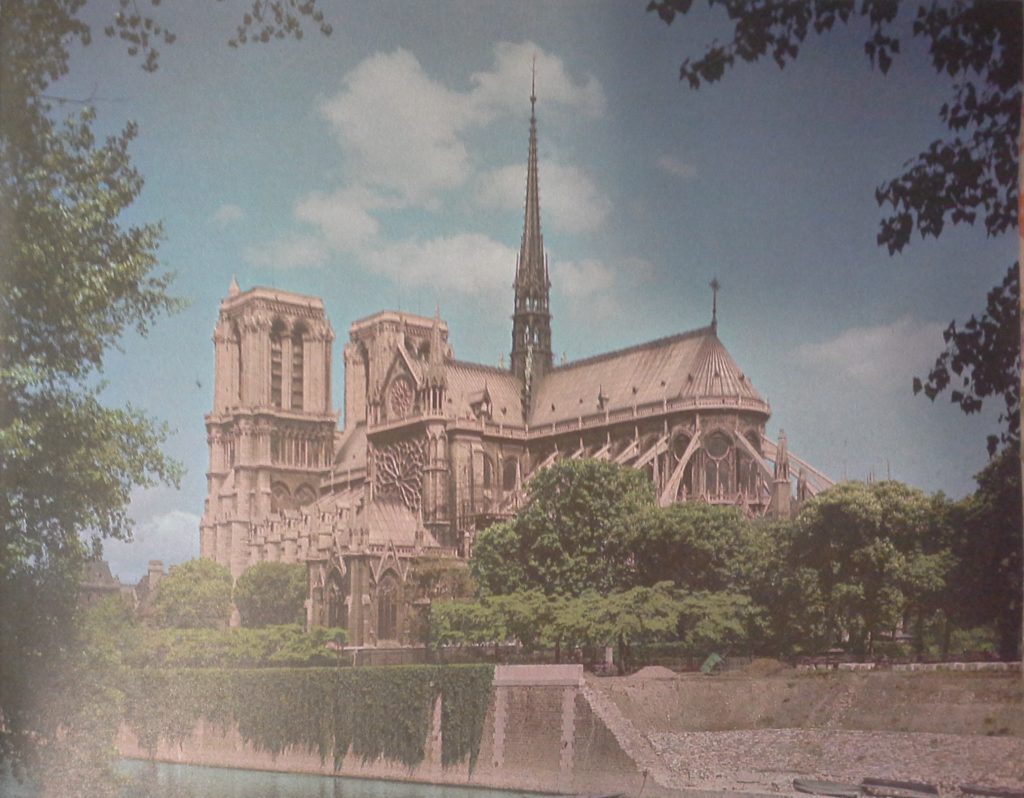
Rising from a little island in the Seine River, the great Gothic cathedral of Notre Dame has dominated the centre of Paris for more than 700 years. Since ancient times, the island on which it stands has been a convenient place to cross the Seine. As a result, Paris became a crossroads of travel and trade during the Middle Ages when the cathedral was built. It was dedicated to Notre Dame (”Our Lady” — Mary, the Mother of Jesus) and the prosperous townspeople of Paris spared no effort to make it worthy of Her. They planned the Interior to be 110 feet high. To reach this height, the building had to be supported by flying buttresses, the shafts of stone you can see braced at an angle against the walls (right). Note also the detailed carving on the towers and in the round window frames in the centre of the cathedral. No wonder Notre Dame took 70 years to build!
The size and beauty of Notre Dame remind us that the Christian Church played a leading role in medieval Europe. In fact, the architecture and art of any period of history are good evidence of what was important to the people who lived at that time. Usually art reflects the things they liked and the ideals in which they believed. This is because an artist puts his time and skill into something which either means a lot to him, or which means enough to other people so they will pay him for it.
We can see the importance of religion to medieval people not only from Notre Dame, but from other beautiful things they created. Look at the cover of a medieval copy of the New Testament Gospels. it is made of solid gold and studded with gems. Or look at the stained glass windows which flooded medieval cathedrals with rainbow-coloured light. Such windows often reflect the pride which townspeople had in their cathedral. One window might be given to the cathedral by the local bakers’ guild, another by the cloth merchants, and so on.
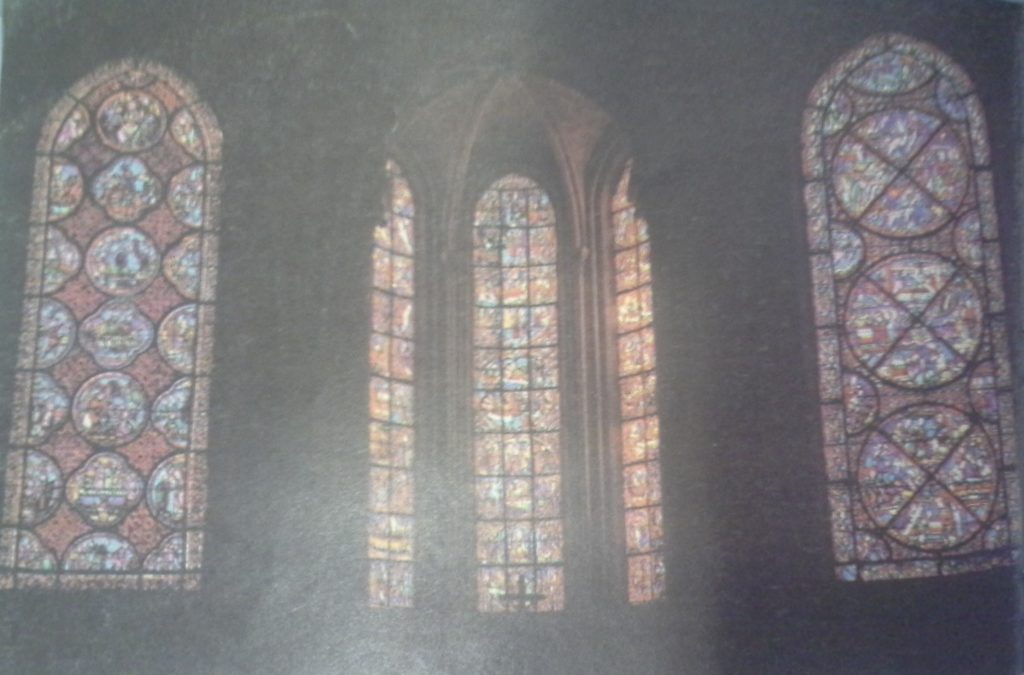
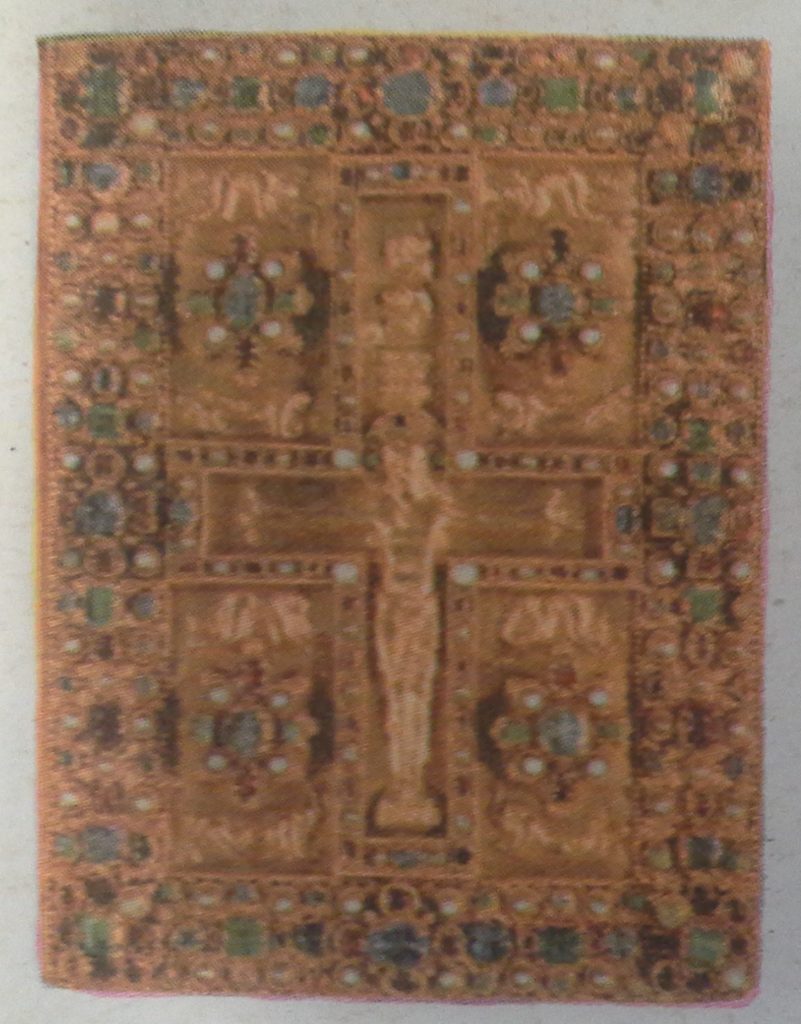
More important to medieval people, however, was the fact that the panels of a window showed different scenes from a Bible story or the life of one of the saints. Many of the nobles and most of the common people were unable to read the scriptures, but when they looked at the windows, they all could recognize Noah’s ark or the dragon killed by St. George. These glowing pictures helped them to learn or remember the saints’ names and the stories of their holy lives. If you think of the windows as magnificent religious ”posters,” you can see again how the art of the Middle Ages met people’s needs.
Medieval art reflects other sides of medieval life as well as religion. The monks who copied books by hand often illustrated them with little paintings of everyday life. Look at the elaborate design (right) drawn on the edge of a manuscript page. The artist included portraits of two of the hardworking peasants whose labour helped support both the church and the nobles. When the illustrator of a Bible wanted to show the wars of the ancient Israelites (below), he painted them and their enemies wearing the chain mail and helmets of medieval knights. This is not an accurate picture of soldiers in Biblical times, but the knight’s ”iron uniform” was familiar to the artist — and to everyone else — in the warlike Middle Ages.

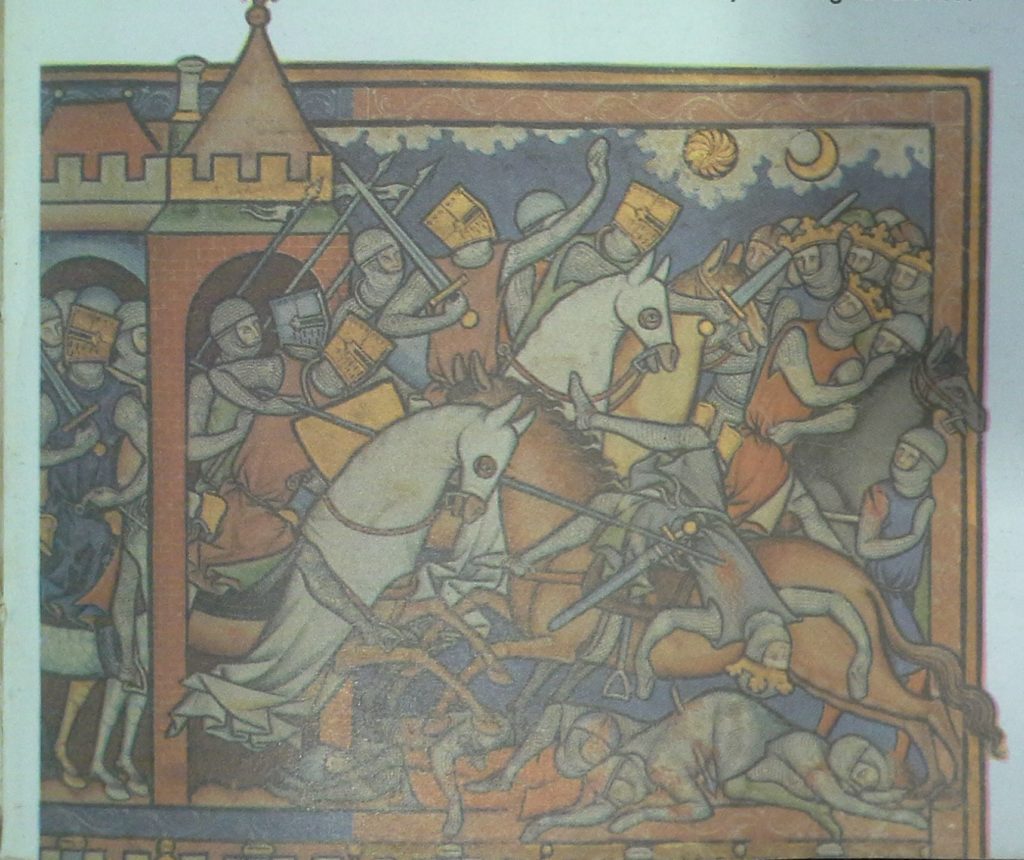
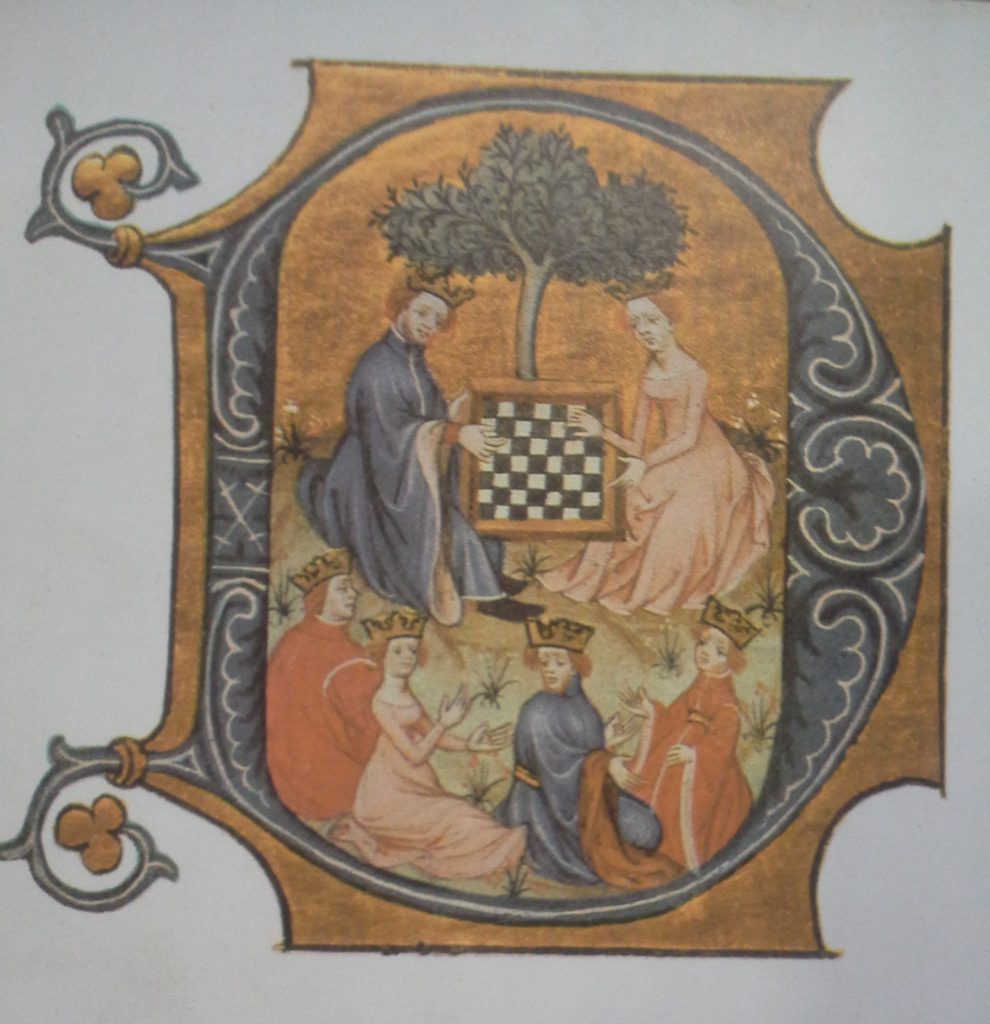
The knights who fought in the Holy Land as Crusaders brought back some information to Europe about the Moslem and Byzantine civilizations of the East. So did traders and travelers. Even before the Crusades, for example, Europeans had learned how to play chess from the Arabs, as shown in the book illustration at left. To most Europeans of the Middle Ages, however, the rest of the world remained a strange place about which they had a few facts and many notions. Look at the tapestry below, which shows the favourite sport of medieval nobles hunting in their own forests. Notice that the animal being hunted is not a stag nor a wild boar, but a white unicorn. In the Middle Ages, many people believed that mythical animals like the unicorn really existed. They had little scientific knowledge and who knew for sure what strange creatures lived in the sky, or the sea, or on other continents? Gradually, curiosity about the unknown world stirred the minds of more and more medieval people until it started the great rebirth of learning which we call the Renaissance.
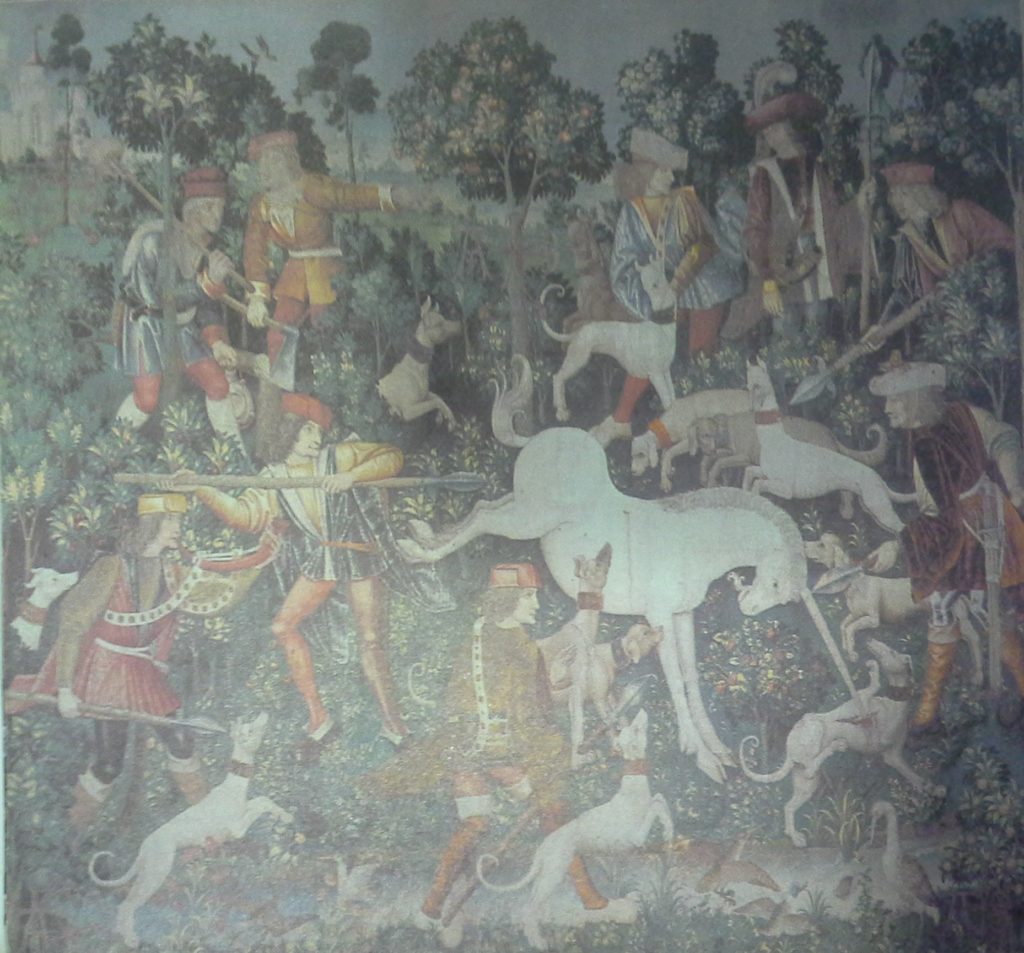
4. What Changes Were Brought About by the Renaissance?
The Renaissance was far-reaching but gradual. Perhaps you have had the experience of living for weeks or months when nothing of importance seemed to happen. Then many interesting events occurred one after the other. In a sense this is what happened to western Europe in medieval times. Until about 1300 life seemed to move along much the same paths. There had really been a great deal of progress, but it came slowly and gradually. Between 1300 and 1600, however, western Europe experienced great and rapid changes. Many of these changes were connected in some way with the rebirth of learning, or the Renaissance.
So important was progress during the Renaissance that some historians used to say it marked the end of the Middle Ages and the beginning of modem times. The change was more gradual than it seemed to be, however, for the “makings” of the Renaissance had existed for hundreds of years. Old bits of knowledge, like that of the roundness of the earth, had long been waiting for men to rediscover them. Moreover, the rebirth of old ideas and the birth of new ideas did not occur in all parts of western Europe at the same time. The Renaissance, therefore, should be thought of not as a single event but as a change of seasons, just as winter gradually changes into spring and just as real spring doesn’t begin all at once on March 21, modern times did not begin abruptly in the year 1500. Seeds of modern life had been growing underground for a thousand years.
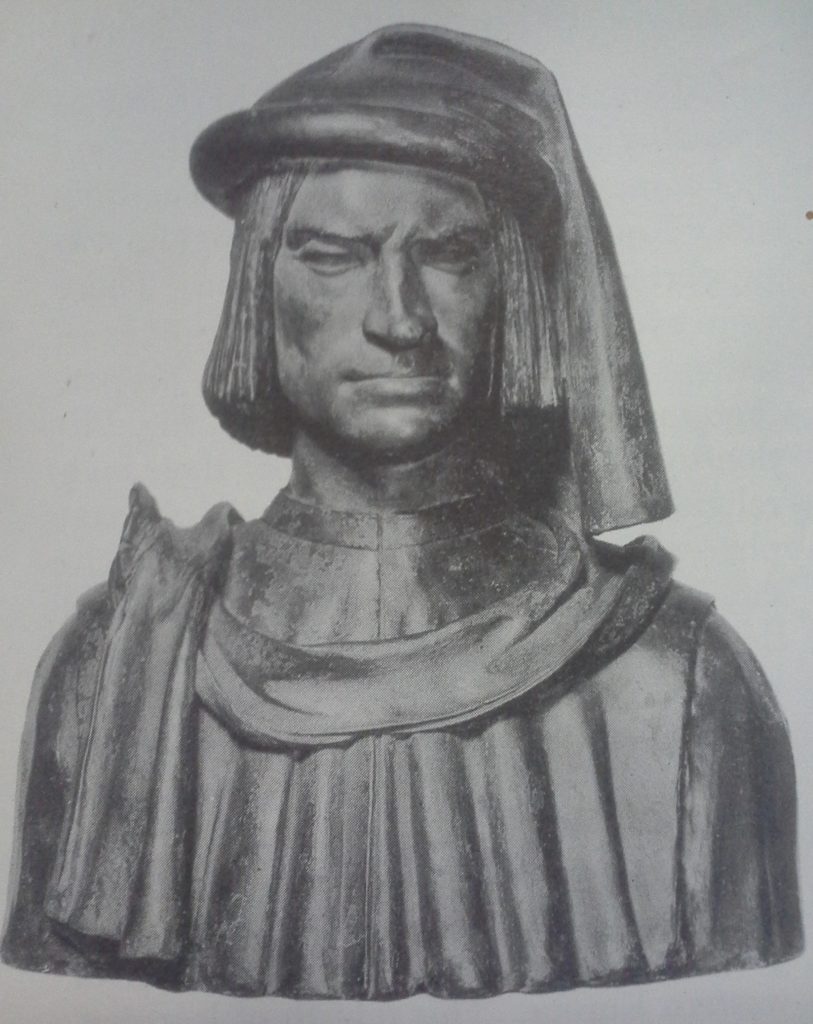
City life encouraged the Renaissance. What caused the Renaissance? High on the list of causes was the growth of town life. As cities became centres of bustling trade and industry, there developed a new and ever expanding middle class of merchants and businessmen. Men of this middle group had the leisure to enjoy literature, the arts and the wealth to encourage struggling writers and artists. Moreover, artists and authors found it easier to work amid the greater safety and freedom of city life.
Italy led the way. For several reasons the first and most striking developments of the Renaissance took place in Italy because it lay directly in the path of the Crusades, such cities as Venice, Genoa and Milan grew rich outfitting and transporting Crusaders. Handling the flourishing trade which had sprung up anew between the Near East and western Europe added greatly to the wealth of these cities. The city of Florence became famous as a banking and industrial centre. Moreover, cities such as Venice, Genoa, Milan and Florence were largely free from outside control. They were practically independent city states, although their affairs were controlled by powerful ruling families.
By the early 1300’s, then, Italy was ready for new ideas. Here were the ruins of a past civilization, daily reminders of “the glory that had once been Rome.” Here were a few scholars who could read Greek. Here also were powerful and wealthy families who vied with one another in encouraging writers and artists. For these reasons, Italy was the first though not the only part of Europe to experience the Renaissance. The movement became strong in France and within the next 200 years the Renaissance had spread throughout western Europe.
The “humanists” encouraged wider study and a new outlook. The Renaissance owed much to certain scholars who located and translated forgotten Latin and Greek manuscripts. These scholars studied the dusty and long neglected manuscripts to find out how the people of the past lived and what they thought. Medieval thinkers had concerned themselves more with matters of religion than with worldly affairs. Scholars who studied the writings of the ancients, however, developed a keen interest in people and the world in which they lived. These men who were interested in the affairs of human beings and studied old Greek and Roman manuscripts to satisfy this interest were called humanists.
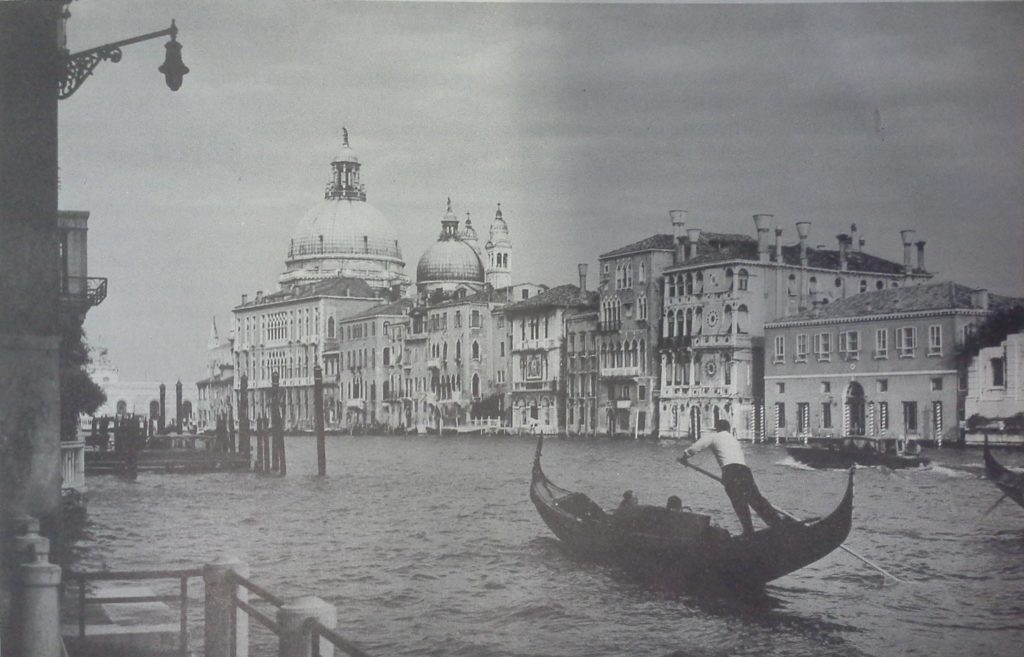
Authors began writing in the people’s language. Latin, as you know, was the language of scholars in the Middle Ages, but Latin was little used by everyday people. In France, Italy and Spain the Romance languages developed from mixtures of Latin and other languages.
Besides collecting and studying long lost Greek and Latin manuscripts and writing in these ancient languages, some humanists used the language of the people. Petrarch, a great poet and scholar who became a monk, wrote in Italian as well as Latin. So also did Dante, one of the world’s greatest poets. Both these men lived early in the period covered by the Renaissance. Dante’s famous poem, The Divine Comedy, is a striking word picture of his ideas of the hereafter. In it he describes great men of the past suffering eternal torment for their sins or lifted to eternal blessedness by their good deeds.
Just as Dante helped to shape the Italian language by writing great poetry in the language of the people, so Geoffrey Chaucer helped to form the everyday speech of England in the 1300’s. His best known poem, The Canterbury Tales, tells of people travelling to the city of Canterbury in England. From the account each person gives about himself — who he is and why he is making the journey the reader gets a colourful picture of England in Chaucer’s time. Although Chaucer wrote in English, the English of Chaucer is an earlier form which you probably would have difficulty in reading. What words can you readily understand in the following lines?
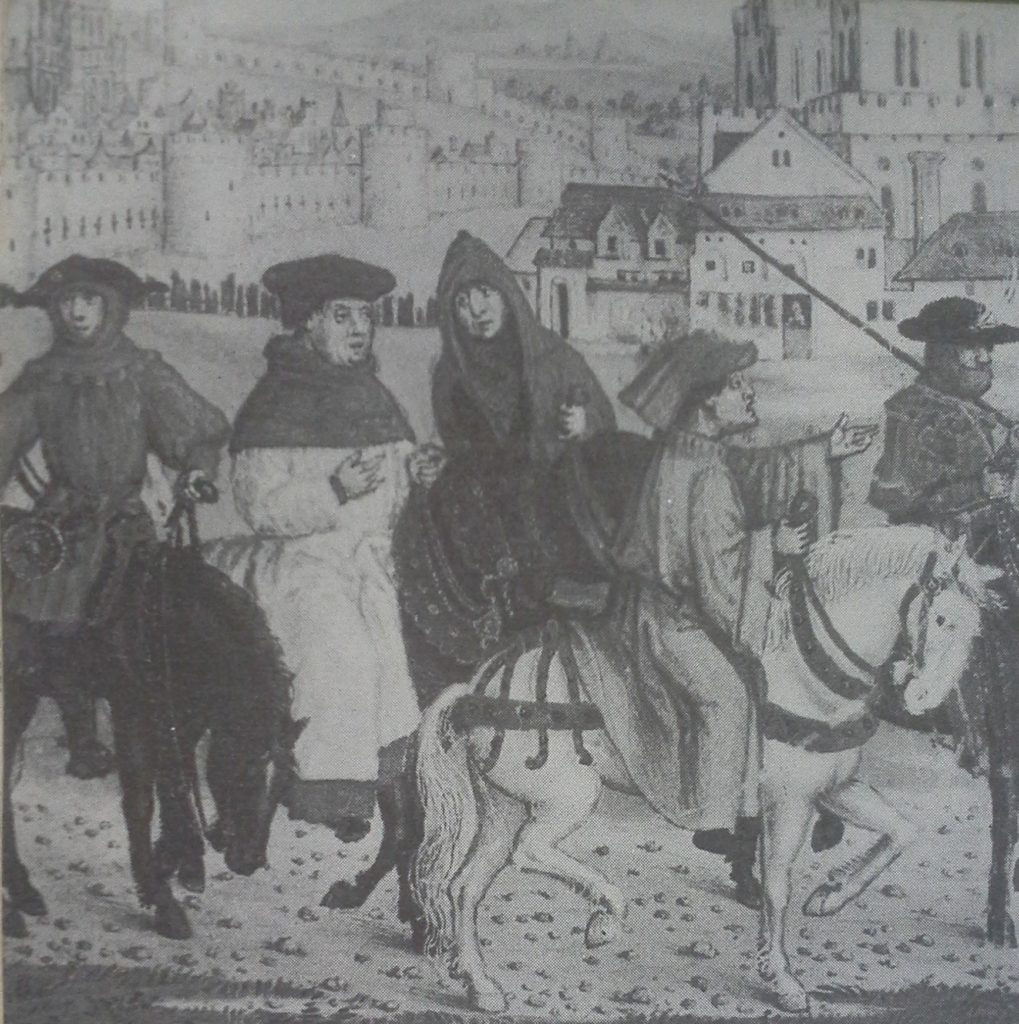
A Knyght ther was, and that a worthy man,
That fro the tyme that he first bigan
To riden out, he loved chivalrie,
Trouthe and honour, fredom and curteisie.
Ful worthy was he in his lordes werre,
And therto hadde he riden, no man farre,
As wel in cristendam as in hethenesse,
And evere honoured for his worthynesse.
Here are these lines turned into modern English:
A knight there was, a very worthy man,
Who, from the time that he first began
To ride forth, loved chivalry,
Truth and honor, freedom and courtesy.
Bravely he fought in his lord’s war,
To which he had ridden (no man farther,
Either in Christendom or among the heathen),
And was ever honored for his bravery.
Europeans learned to print books from type. Few Europeans could enjoy the new literature so long as books were made by painstakingly copying manuscripts letter by letter. The Chinese had been familiar with printing for hundreds of years, but in Europe the development of printing was slow. First, a cheap material like modern paper was needed. Both papyrus (originally used by Egyptians) and parchment were too expensive, for papyrus had to be made from reeds and parchment from sheep skins and calfskins. Fortunately in Spain and the Near East Europeans learned from the Moslems how to make paper from rags. Some paper is still made in this way, though most inexpensive paper is made from wood pulp.
Europeans in the Middle Ages had learned to bind pages of paper together to form a book. They were also accustomed to stamping designs from carved wooden blocks. A German named Johann Gutenberg is generally considered the first European to apply the idea of stamping with blocks of wood or metal shaped into type. The blocks, each with a single letter, could be put together to form words. Gutenberg then wedged the pieces of type into a frame, inked the type and pressed a sheet of paper over the inked letters. Shortly after 1450 the famous Gutenberg Bible was printed on this crude printing press. The Gutenberg Bible was one of the earliest printed books of which copies still exist.
The printing press brought great changes. It is difficult to imagine a more significant invention than the printing press. Now that books could be mass produced rather than copied one by one, more books were printed. There was more work for papermakers and for book binders. To be sure, good penmen who had copied manuscripts lost their jobs, but in the end more people found work in the book business than ever before. Printed books had fewer errors, too, because each copy of a single book was like all the other copies printed from the same type. A printer might make one mistake, which would appear in each of a thousand copies, but every time a manuscript was copied by hand, not only were old errors retained but new ones crept in.
As more books became available and prices dropped, more people learned to read. This fact helped to do away with differences in word forms, spelling and grammar. Different ways of speaking within the same country tended to disappear because the same written forms of the language were taught to children of every region. People also became better educated as ideas, new and old, spread more readily.
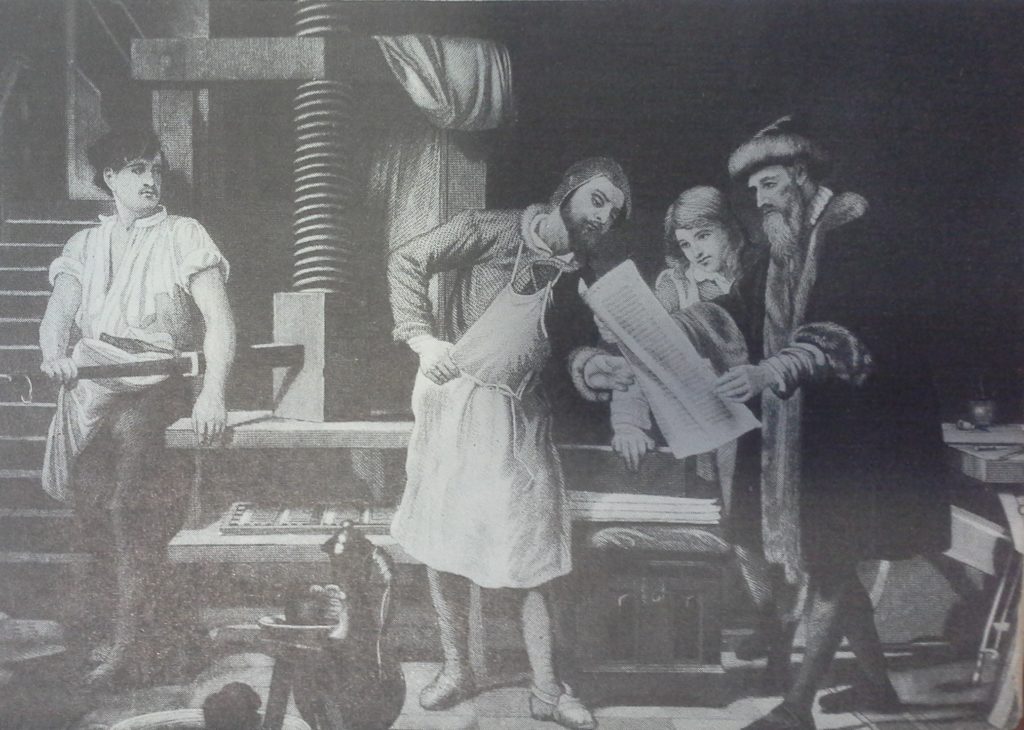
Johann Gutenberg, probably the first European to print with movable type, examines a page fresh off the printing press. After his invention in the 1450’s, printing spread to many parts of Europe.
Writers started people thinking. Many of the new ideas came from the pens of humanist writers. Some writers put their ideas about government into books. One such writer was an Englishman, Sir Thomas More. He described an imaginary country Called Utopia, where the laws and customs were perfect. (We still speak of certain ideas and ideals as “utopian” when we have some doubts whether they will work.) Other writers attacked or ridiculed what they saw about them. A French author, Rabelais, poked fun at people by creating two fairy tale giants who said and did some of the foolish things of the times. A French lawyer and writer, Montaigne, protested against people’s unwillingness to accept the viewpoint of others. Montaigne’s common sense helped to calm the bitter struggle then going on over religion. The great Dutch scholar Erasmus wrote vigorously against narrow mindedness and intolerance. Justice and freedom, Erasmus believed, never could be gained by using violence but only by straight thinking and freedom to criticize ideas. In sharp contrast was a book called The Prince, written by an Italian, Machiavelli. Among other things, this book described the tricky methods that ambitious rulers can use to gain absolute power — then or today!
Modern science started slowly. In Europe during the Middle Ages little attention was paid to science. To be sure, a few bold scholars, like the English monk Roger Bacon, foresaw the possibilities of science. As early as the 1200’s, Bacon urged scientists to make experiments and predicted that one day men would drive horseless carriages and fly through the air. He experimented with lenses and made small amounts of gunpowder. For the most part, however, medieval scholars did little to increase their knowledge of nature. They clung to accepted notions and distrusted scientific experiments. They devoted their time to studying Aristotle’s ideas rather than to developing new theories of their own. Science did not affect their daily lives as it does everyday living today.
Copernicus proposed a new theory of our universe. During the Renaissance, however, a number of men took a new interest in the world in which they lived. One of the questions pioneer scientists of the 1500’s and 1600’s asked themselves was this: How does our universe — the stars, the sun, the moon, the earth and other planets — operate? For centuries people believed the earth was the centre of the universe and that other bodies revolved about it. But in 1543 a Polish astronomer named Copernicus came forward with a startling theory. He declared that the earth moves in an orbit or path around the sun. He also claimed that other planets or heavenly bodies swim in space in their orderly processions around the sun. These beliefs of Copernicus were backed up by later scientists and are today accepted by almost everybody.
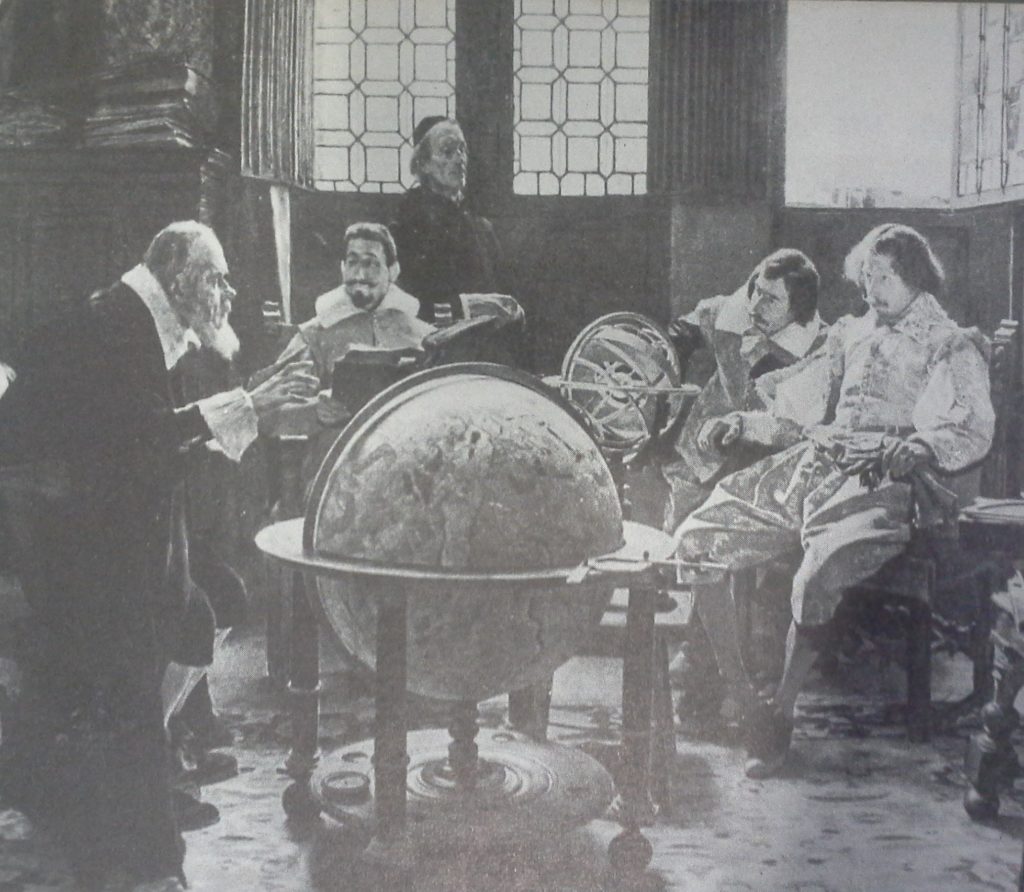
Galileo’s experiments aided the growth of scientific knowledge. In the 1580’s an Italian scholar, Galileo, watched the bronze lamps suspended from the ceiling of the cathedral of Pisa. He asked himself a question: Why did those lamps on their long chains continue to swing endlessly back and forth? Challenged by this question, Galileo went to work to discover the principles which govern the movement of a pendulum. He proved by experiment that the length of a pendulum, not its weight, decides the time required for each swing.
A few years later Galileo asked himself whether light and heavy objects fall at different speeds. Aristotle had said that they did, but Galileo wanted to find out for himself. From the leaning tower of Pisa he dropped objects of different weight. They fell at the same speed! Then Aristotle must be wrong. By refusing to take anything for granted, Galileo commenced the science of mechanics, a branch of physics. His ideas caused violent disagreements and got him into trouble with Church authorities but started other scholars thinking along new lines.
To carry on his experiments, Galileo needed accurate instruments. He did not invent the telescope, but he improved it greatly. With the aid of his telescope Galileo discovered the moons circling the planet Jupiter. The lenses could also be used in microscopes. So by the 1600’s men were able not only to peer into distant space but to examine bits of matter hardly visible to the unaided eye. Galileo’s discoveries also hastened the development of such instruments as the thermometer, the barometer and more accurate timepieces .
Art changed in the 1400’s and 1500’s. The people of the Middle Ages loved beauty. Proof of this is to be found in the thousand little details of ornament on everything from a sword hilt to a lady’s bracelet, in beautifully illuminated manuscripts and in the stained glass windows and towering spires of Gothic cathedrals. Medieval artists and sculptors produced many pictures and carvings of religious subjects, but Europeans in the Middle Ages lacked much of the knowledge about art that the people of ancient times had possessed.
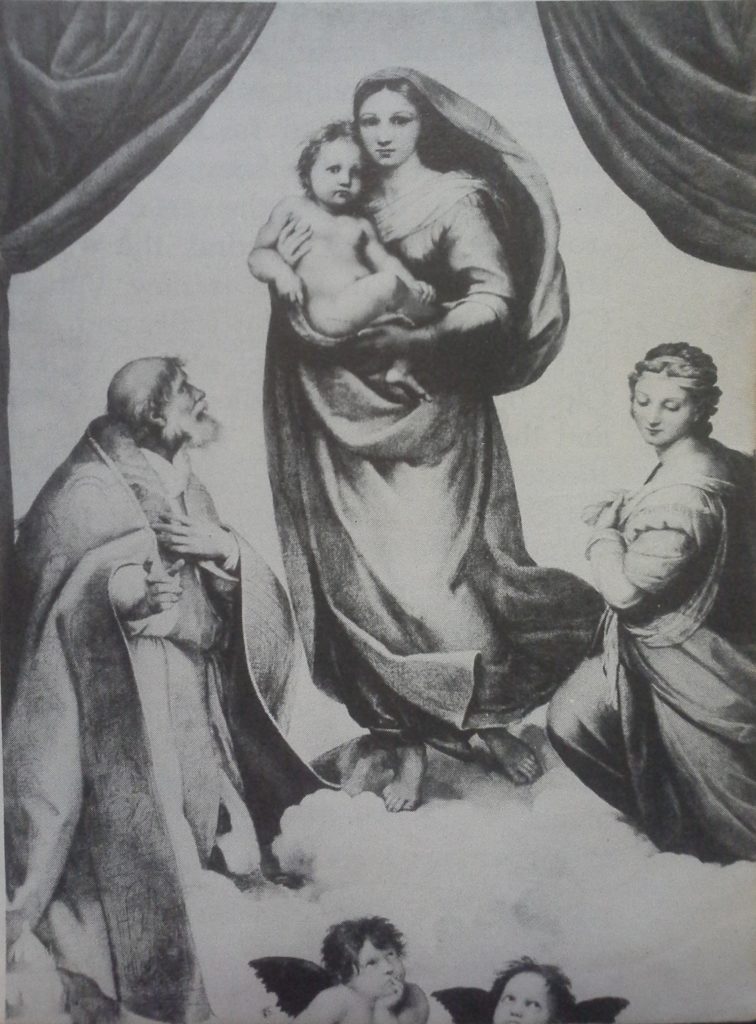
You may remember the lifelike statue of a Greek boy pulling a thorn from his foot and the rippling muscles of a Greek athlete throwing the discus. In the art of ancient Greece, Renaissance artists and sculptors rediscovered lifelike and natural qualities that were lacking in the stiff subjects carved and painted in the Middle Ages. They came to realize that beauty of line and form was an important thing in itself. Although religious subjects continued to be popular, Renaissance artists became increasingly interested in portraying people and the world about them. They painted pictures and carved statues that were thoroughly lifelike. They found ways to show the comparative sizes and distances of objects, problems that had troubled most earlier painters.
Much of the best Renaissance painting and sculpture was the work of Italians. If anyone today were to select the three most famous paintings of the Renaissance period, he might very well choose Michelangelo’s Creation of Adam, Raphael’s Sistine Madonna and Leonardo da Vinci’s The Last Supper. The painters of these three masterpieces were Italians.
Michelangelo and da Vinci stood out in an age of remarkable men. Leaders of the Renaissance were men with interests and accomplishments in many fields. Can you think of a person today who is world famous both as a sculptor and as a painter, who is also a great architect and engineer, a statesman and a poet of the first rank? Michelangelo of the city of Florence was all of these. Working long hours and with tremendous energy, he could carve a statue out of a block of stone without making preliminary clay models as most sculptors do. His statues of David (completed in 1504) and of Moses are among the finest ever carved. Michelangelo designed the vast dome that crowns St. Peter’s Cathedral, the world’s largest church, in what is now Vatican City. He painted on the walls and ceilings of the Sistine Chapel, also in Vatican City, the great scenes called the Creation and the Last Judgment. To this day, on the ceiling of the Chapel, can be seen the perfection of Michelangelo‘s work in all its splendid colour, line and form.
Another remarkable man of the Renaissance was Leonardo da Vinci. He also lived in Florence and like Michelangelo, was an expert in more than one art. Da Vinci was a painter you may have seen copies of his painting entitled The Last Supper or his famous Mona Lisa. He was also a sculptor, architect, engineer, scientist and philosopher. In science, da Vinci was so far ahead of his time that people who did not understand his work called him a magician. Not only did he invent a number of useful machines, but he left us sketches of many others, all based on sound scientific principles, which forecast modern inventions. He studied birds in his attempt to discover the principle of flight and constructed models of what today we would call helicopters, complete with propellers! No one has ever combined greater genius in art and science than Leonardo da Vinci.
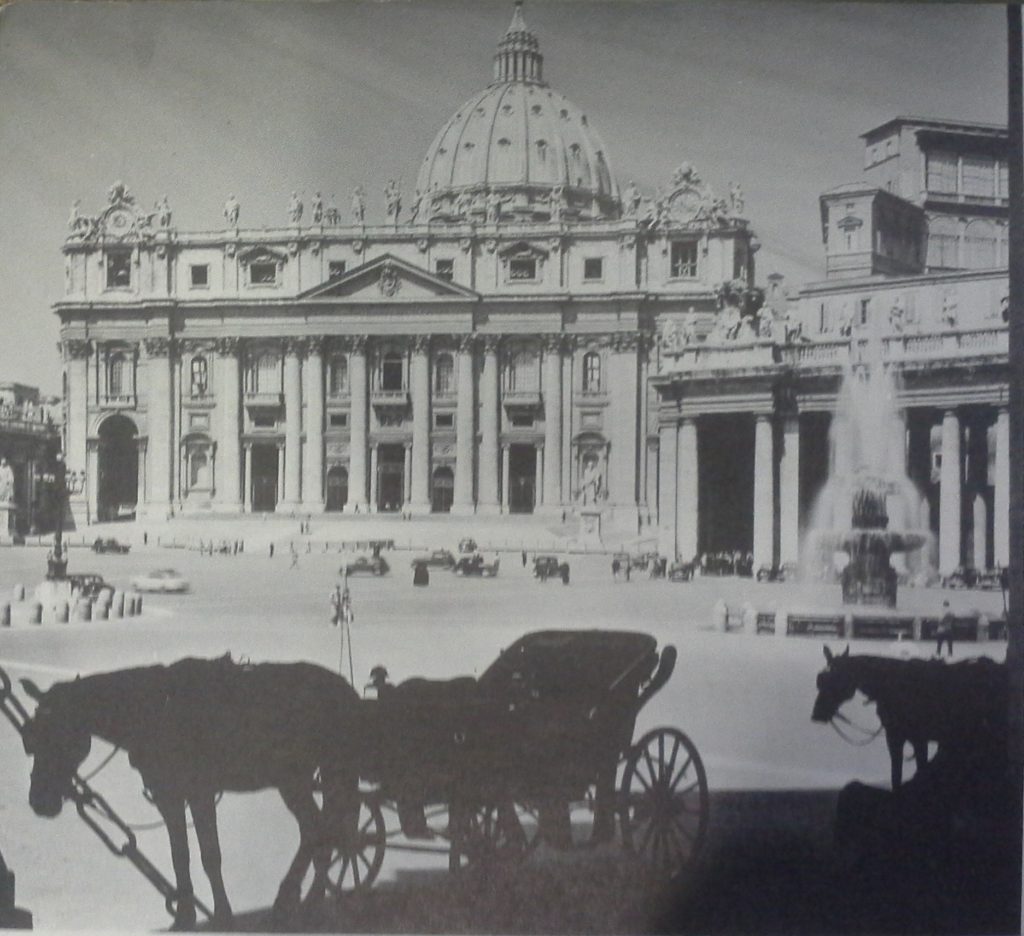
Renaissance art was not limited to Italy. Italian churches, public buildings and homes of the wealthy were filled with the work of the great artists and sculptors of Rome, Florence, Venice, and other Italian cities. In Spain and Holland, during the Renaissance and in the century or so following, there were artists who rank among the best. Perhaps you have seen Velasquez’ pictures of King Philip IV of Spain. In the 1600’s the Low Countries boasted such painters as Rubens, Van Dyck and the great Rembrandt. The latter went into debt buying jewelry for his wife, so he painted pictures of himself when he could not afford to hire models. Rembrandt’s self portraits are among the world’s greatest paintings. The Dutch painters, in the main, preferred scenes from everyday life: groups in taverns, cattle grazing peacefully, matrons and merchants, soldiers marching off to war, boys at play. The best paintings of Renaissancc artists in Spain and the Low Countries, as well as Italy, were both beautiful and true to life. Many believe them to be the greatest of all time.
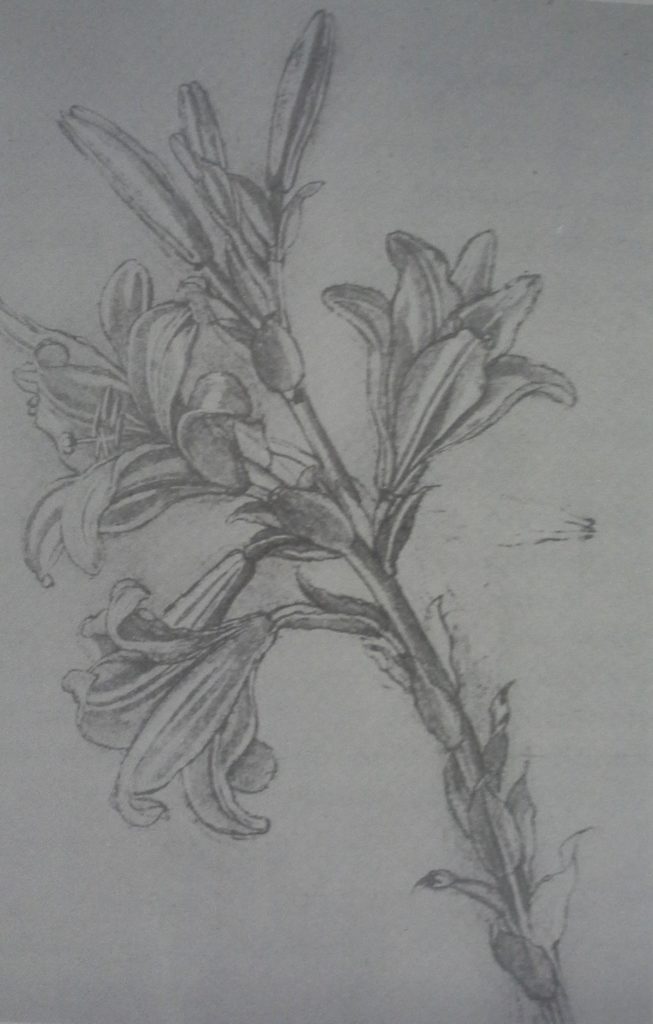
Music developed in the Middle Ages and during the Renaissance. Church music of the early Middle Ages was the forerunner of various kinds of music that we have today. Organ music and choir chanting were common in church services. Early churchmen hit upon the idea of a musical scale of eight notes and invented a way to write music by using letters of the alphabet. Between 1000 and 1500, music advanced greatly. Rules of rhythm were discovered and composers of music learned how to combine tones pleasingly in chords (notes sounded together) and in melodies (tunes).
By about 1500 there came a change in the music used in the Catholic churches. Palestrina (pal uh stree’nuh), one of the first great composers of Renaissance times, was chiefly responsible. Palestrina, who became well-known as a choirmaster, wrote church music that was simple, rhythmic and melodious. In all he composed over a hundred beautiful Masses.
Music during the Middle Ages and the Renaissance, however, was not confined to church music. Travelling singers called troubadours in France, minnesingers in Germany and Minstrels in England wandered about singing songs of adventure, love and war. They delighted their listeners in castle halls, in public squares and at fairs by singing old ballads or composing new ones. In time, their melodies and the improved music of churchmen paved the way for some of the greatest masters of musical composition of all time.
By the time of the Renaissance, conditions in western Europe had undergone great change. To be sure, for those who lived in the country, life remained much the same. Those who had made their way to larger communities found a new and more exciting kind of living. Some became merchants, while others apprenticed themselves to masters of a craft and learned a useful trade. Most of them, if they stayed in the cities, found that “city air is free air.”
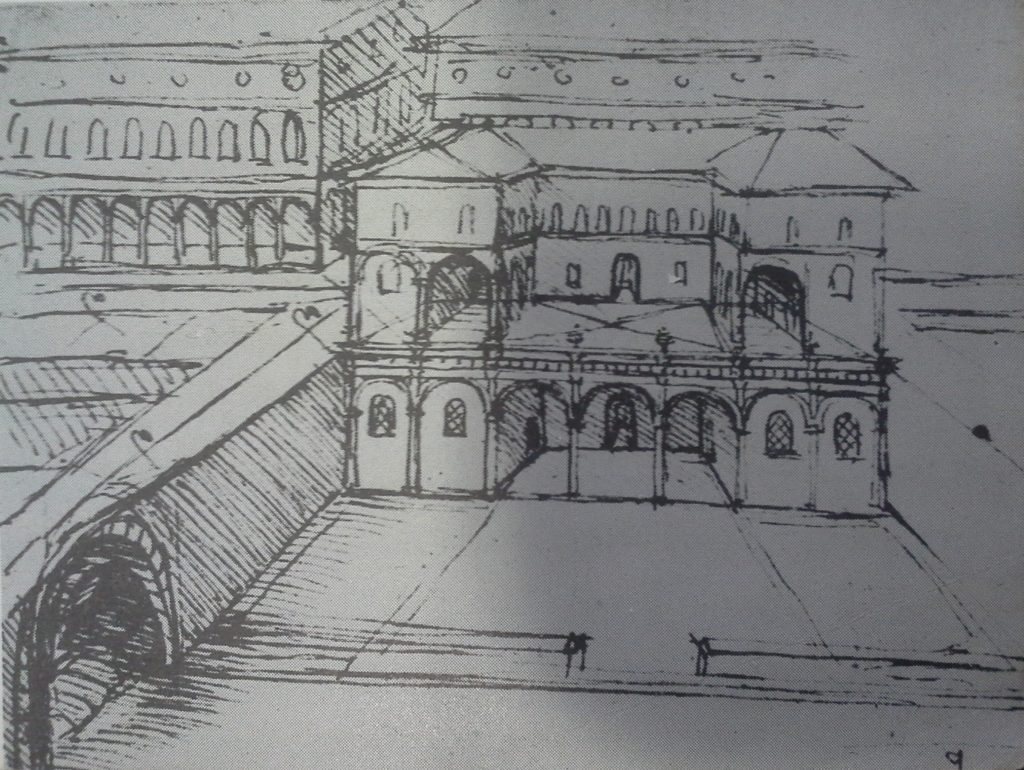
Between about 1000 and 1500, universities opened in various cities of western Europe and opportunities for schooling increased. The people of western Europe slowly rediscovered Greek and Roman civilization. To what the ancients had handed down to them, thinkers added their own ideas. Interest in people and the world in which they lived led to new achievements in science, literature, architecture, painting, sculpture and music.
